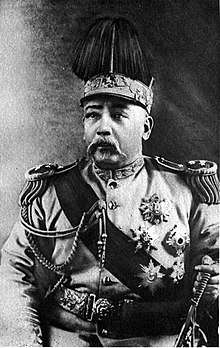1912 Republic of China provisional presidential election
The 1912 Republic of China Provisional Presidential and Vice-Presidential Elections were the elections held on 15 February and 20 February 1912 in Nanjing for the second provisional President and Vice President of the Republic of China respectively.
| |||||||||||||||||
| |||||||||||||||||
| |||||||||||||||||
After the Wuchang Uprising on 10 October 1911, Yuan Shikai, the powerful military officer was reappointed to lead the Beiyang Army by the Qing court. Yuan realized that Manchu's days were numbered and decided to establish a government himself.[1] He attacked the revolutionaries to show his power, however left the negotiations open. After the revolutionaries promised him the presidency, he pressed the Qing court to abdicate. On 12 February 1912, the court authorized Yuan to organize a provisional republican government. Three days later, the incumbent provisional president Sun Yat-sen resigned and urged the National Assembly to elect Yuan.
Yuan Shikai and Li Yuan-hung were elected as President and Vice-President respectively. Yuan sworn in on 10 March 1912 and moved to government to Beijing.
Vote summary
Presidential election
| Party | Candidate | Votes | Percentage | |
|---|---|---|---|---|
| Non-partisan | Yuan Shikai | 17 | 100% | |
| Total | 17 | 100.00% | ||
Vice-Presidential election
| Party | Candidate | Votes | Percentage | |
|---|---|---|---|---|
| Nonpartisan | Li Yuanhong | 17 | 100% | |
| Total | 17 | 100.00% | ||
See also
- History of Republic of China
- President of the Republic of China
- Vice President of the Republic of China
Citations
- Hu, Shaohua (2000). Explaining Chinese Democratization. Greenwood Publishing Group. p. 47.
References
- 中央選舉委員會,中華民國選舉史,台北:中央選舉委員會印行,1987年
